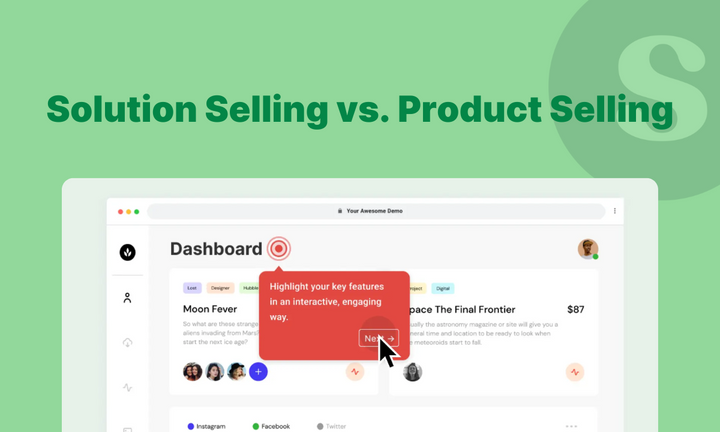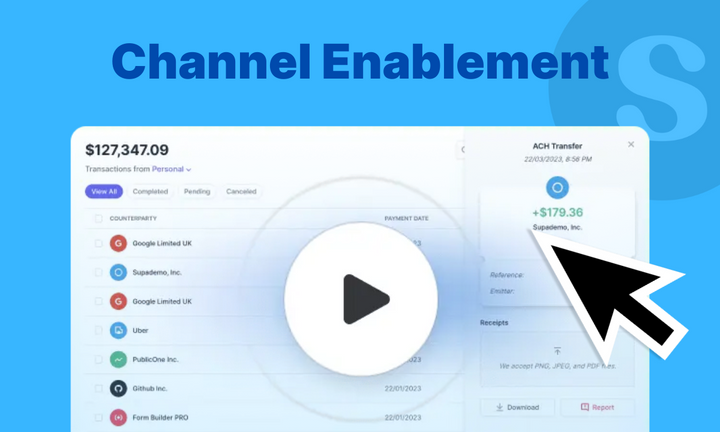Consider this scenario: As an event organizer, you're well aware of the difficulties involved in attracting attendees to your event through various marketing channels. However, convincing those attendees to purchase tickets and actively engage in the event can pose an even greater hurdle. It's similar to trying to sell concert tickets to someone who has no interest in music - they simply won't be motivated. But don't despair! Conversion Rate Optimization (CRO) comes to the rescue as the solution that can transform apathetic event-goers into enthusiastic participants, ultimately boosting your attendee-to-ticket-buyer ratio.
By incorporating 9 established techniques for Conversion Rate Optimization (CRO), such as split testing and multivariate testing, you can swiftly attain your desired conversion objectives. Stay vigilant of Supademo, and make effective use of Google Analytics to monitor your advancements.
Having clear objectives for maximizing conversions and a deep understanding of your conversion funnel, you can align your efforts with your goals and avoid common mistakes that hinder your average conversion rate. Now is the opportune time to transform those visitors into loyal customers who are actively involved and willing to make purchases by leveraging the potential of CRO!
What does Conversion Rate Optimization entail? You may be curious about the exact definition of Conversion Rate Optimization. It's the skillful combination of art and science aimed at transforming website visitors into enthusiastic potential customers. According to Econsultancy, companies that invest in CRO and implement effective digital marketing strategies and funnels are more likely to witness improved return on investment (ROI) within three months.
By optimizing the design, content, and overall customer experience of your website, you make it more user-friendly and encourage visitors to take desired actions, whether it's submitting a feedback form, making a purchase, or subscribing to a newsletter. It's like equipping your website with a superhero cape, ready to save the day!
Think of CRO as a means to empower your website on search engines, enhancing your conversion rate and maximizing its productivity. It goes beyond simply boosting your conversion rate; it's about crafting a seamless and delightful digital journey for your potential clients that leaves them wanting more.
Unlocking the Potential of Your Traffic: Recognizing the Significance of CRO
Are you tired of encountering silence when it comes to your website's conversion rate? You're not alone. Research indicates that the average conversion rate for websites stands at a mere 2.35%. That's akin to engaging in a staring contest with a statue. But fear not, Conversion Rate Optimization (CRO) can be your hidden weapon to transform those silent visitors into vocal prospective clients.
Let's explore the compelling reasons why CRO holds significant importance:
Unveiling Effective Elements: CRO empowers you to identify the strengths and weaknesses of your website, enabling you to allocate your resources efficiently. This saves valuable time and money by directing your focus toward the crucial features and areas that require improvement.
Amplifying Lead Generation: By optimizing your landing pages and forms, CRO can effectively increase the volume of leads generated from your website. This boost in lead generation paves the way for potential conversions and business growth.
Elevating Customer Experience: Enhancing the overall customer experience, especially on mobile devices, establishes credibility and trust among potential prospects. This positive experience contributes to an increase in sales and referrals, fostering long-term customer loyalty.
Staying Competitive: CRO empowers you to continuously test and enhance your website's performance on search engines, ensuring you stay ahead of the competition. By remaining proactive in optimizing your website, you maintain a competitive edge in the digital landscape.
Data-Driven Decision Making: By utilizing tools like Google Analytics to track and measure the success of your digital marketing assets and campaigns, CRO enables you to make informed decisions based on data. This data-driven approach allows for more effective planning and strategizing for future endeavors.
Embracing CRO provides a multitude of benefits, including optimizing website elements, generating more leads, enhancing customer experience, staying competitive, and making data-backed decisions.
Let's delve into the concept of Average Conversion Rate (ACR):
You have a website, you're driving traffic to it, and you're eager to convert those visitors into paying ideal customers, thereby boosting conversions and enhancing your marketing operations. But what exactly constitutes a good conversion rate to strive for? That's where the Average Conversion Rate (ACR) comes into play. ACR represents the percentage of website visitors who successfully complete the desired action, such as making a purchase, filling out a form, or signing up for a newsletter.
Consider the following key points when it comes to ACR:
Industry Variations: The average ACR can vary significantly across industries, ranging from as low as 1% to as high as 20%. Understanding the specific benchmarks for your industry in the context of demo software can provide valuable insights and benchmarks for comparison.
B2B vs. B2C: In the B2B sector, the average ACR tends to be lower compared to B2C industries. However, this doesn't imply that improvement is impossible. By implementing tailored CRO strategies designed for the demo software niche, you can enhance your conversion rates and achieve better outcomes.
Influencing Factors: ACR can be influenced by various factors, including website design, user experience, copywriting, and the timing of interactions. Paying attention to these elements and optimizing them can have a positive impact on your ACR.
Setting Realistic Expectations: Determining a suitable average conversion rate to aim for depends on factors such as industry norms, your specific goals, and the type of conversion you are targeting. It's important to establish realistic expectations and continually strive for improvement.
Website Load Time: Studies have highlighted the crucial role of website load time in conversions. Even a mere one-second delay can lead to a significant decrease in conversions, while a fast-loading website can substantially improve the conversion rate. Optimizing the speed and performance of your website is essential for maximizing conversions.
Calculation Process: Calculating your conversion rate involves several steps. First, define your conversion goal, such as form submissions or purchases. Next, choose a specific time period and track the number of conversions during that period. Finally, divide the number of conversions by the number of website visitors and multiply by 100 to obtain the conversion rate as a percentage.
Understanding ACR helps you gauge the performance of your website's conversions. By considering industry variations, optimizing influencing factors, setting realistic expectations, and prioritizing website performance, you can strive for continuous improvement in your conversion rates.
Let's explore the top 9 CRO strategies for marketers in 2023, focusing specifically on demo software:
1) Conduct User Research: Begin by conducting user research to gain insights into the needs and preferences of your target audience. This will enable you to customize your website and conversion tactics to cater to their specific requirements.
2) Optimize Your Landing Pages: Enhance the performance of your landing pages using A/B testing, personalization, and simplification techniques. Experiment with different call-to-action buttons and personalize content to boost conversion rates.
3) Create Irresistible Offers: Provide enticing incentives such as free trials, limited-time discounts, or other offers that make it hard for visitors to resist taking action. Highlight the value of your demo software to drive product-led growth.
4) Use Social Proof: Display testimonials, ratings, and reviews from satisfied customers on your website and social media platforms. Showcasing positive experiences builds trust and credibility for your demo software.
5) Improve Site Speed: Optimize your website's speed by reducing image sizes, employing a content delivery network, and minimizing HTTP requests. Faster loading times enhance the user experience and lead to increased conversions.
6) Optimize Your Forms: Simplify and visually enhance your lead generation forms. Provide clear instructions and only ask for necessary information to improve conversion rates.
7) Use Retargeting Ads: Implement retargeting ads to stay top-of-mind with prospects who have shown interest in your demo software. Target them with relevant ads to boost brand awareness and conversions.
8) Personalize Your Website: Utilize data and insights to create a personalized user experience. Tailor your website's content and messaging to align with each visitor's unique interests and preferences.
9) Add Interactive Demos: Implement Supademo's interactive demo software to showcase the value and features of your product. Engage visitors and provide a firsthand digital experience to increase their interest and conversion rates.
These strategies have demonstrated effectiveness across various industries, including demo software. By implementing them in your marketing efforts, you can optimize your conversion rates and achieve better results.
Additionally, let's explore three real-life examples of successful CRO implementations:
- HubSpot: HubSpot offers a free CRM tool and utilizes targeted messaging and personalized email campaigns to upsell users to their paid plans. This strategy resulted in a 165% increase in paid users within 12 months.
- Salesforce: Salesforce simplified its signup process by reducing the number of fields on the registration form. This change led to a 50% increase in signups. They also added a progress bar to enhance the user experience and further boost completion rates.
- Crazy Egg: Crazy Egg employed A/B testing to improve their pricing page design. By experimenting with different layouts, headlines, and colors, they achieved a 64% increase in conversions.
These examples highlight how companies have effectively implemented CRO strategies to improve their conversion rates. By adapting similar tactics to your demo software and incorporating them into your CRO approach, you can elevate your conversion optimization efforts and achieve better results.








